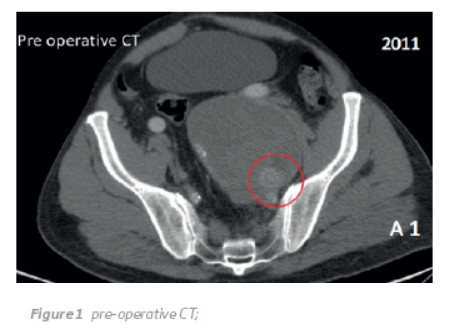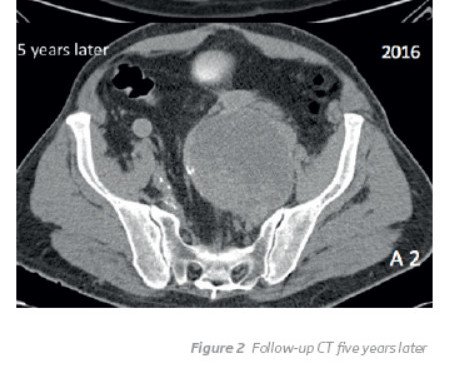Serviços Personalizados
Journal
Artigo
Indicadores
-
 Citado por SciELO
Citado por SciELO -
 Acessos
Acessos
Links relacionados
-
 Similares em
SciELO
Similares em
SciELO
Compartilhar
Angiologia e Cirurgia Vascular
versão impressa ISSN 1646-706X
Angiol Cir Vasc vol.14 no.2 Lisboa jun. 2018
CASO CLÍNICO
Giant hypogastric artery aneurysm after previous abdominal aortic aneurysm exclusion, with a hostile abdomen and anatomy
Aneurisma gigante da artéria hipogástrica após exclusão prévia de AAA
Luís Machado1,2, Armando Mansilha1,2
1Department of Angiology and Vascular Surgery, São João Hospital Center
2Faculty of Medicine, University of Porto
Autor para correspondência
ABSTRACT
The widespread use of various imaging modalities, allow that hypogastric aneurysms have been increasingly detected. Usually asymptomatic, but once clinical symptoms occur, it must be supposed immediately that the hypogastric aneu•rysms have ruptured or that is compressing neighboring abdominal structures.
We describe a patient with a giant hypogastric aneurysm, after a AAA repair, compressing the ureter and spinal roots, treated by open surgery.
Keywords: Hypogastric artery aneurysm; compression symptoms
RESUMO
O uso generalizado de exames imagiológicos, permitiu o maior diagnóstico de aneurismas da artéria hipogástrica.
Geralmente assintomáticos, mas quando causam sintomas, deve-se supeitar de rutura ou compressão de estru•turas abdominais próximas.
Descrevemos um doente com um aneurisma gigante da artéria hipogástrica após correção cirurgica de aneurisma da aorta abdominal, causando compressão do ureter e das raizes nervosas, tratado por cirurgia aberta.
Palavras-chave: Aneurisma da artéria hipogástrica; sintomas compressivos
INTRODUCTION
Hypogastric artery aneurysms have been increasingly detected because of more imaging modalities performed for different clinical situations. When symptomatic, it must be supposed that the hypogastric aneurysms have ruptu•red or that they are compressing neighbouring abdominal structures.(1) We describe a patient with a giant hypogas•tric artery aneurysm, after an abdominal aortic aneurysm repair, compressing the ureter and spinal roots, treated by open surgery.
CASE REPORT
A 75-year-old male with history of an aorta-iliac aneurysm (both common iliac arteries involved) treated in 2000 with an aorto-bifemoral bypass and proximal and distal ligation of the iliac aneurysms. In 2006 had a new left hypogastric aneurysm, that was attempted to exclude by proximal ligation.
Observed in again 2011 because of abdominal pain. An angio-CT was performed and revealed a left hidrone•frosis and compressed spinal roots by the "recanalyzed" hypogastric aneurysm with 12x10 cm of diameter (Figure 1), that was excluded by open surgery, with control of back bleeding with endoaneurysmorrhaphy and packed with haemostatic agents.

Five years after this last procedure an angio-CT was performed and showed the hypogastric aneurysm comple•tely excluded, without contrast enhanced, even in later acquisition times (Figure 2).

DISCUSSION
Treatment of hypogastric artery aneurysms is a challen•ge due to their topography in the pelvis. The large size at diagnosis and the adjacent structures increase the risk of iatrogenic lesions .(2)
The current available treatments for hypogastric aneurysms are one or a combination of ligation, excision, endoaneurys•morrhaphy, embolization and endoluminal stenting.(3)
Aneurysm proximal ligation is the simplest procedure but carries a risk of long-term complications because the aneurysm is still supplied by collaterals and thus may conti•nuing to expand and may even rupture or cause compressi•ve symptoms.(3)
Despite endovascular evolution, open surgery may be the best approach for hypogastric aneurysms causing compression symptoms.
REFERENCES:
1. Morishita A, Tomiaka H, Katahira S et al. Open Surgery for Giant Bilateral Internal Iliac Artery Aneurysms with Compression of Neighboring Abdominal Structures: A Case Report, Ann Vas Dis. 2015; 8(3): 265-267. [ Links ]
2. Afonso C, Procópio R, Navarro T et al. Ruptured internal iliac artery aneurysm: case report. J Vasc. Bras. 2009; 9: 93-96. [ Links ]
3. Greco L, M. Tedeschi M, Angiletta D et al. Large Isolated Hypogas•tric Artery Aneurysm Compressing Both Pelvic Ureters. Eur J Vasc Endovasc Surg. 2009; 18, e63-e65. [ Links ]
Correio eletrónico: lmachado.med@gmail.com (L. Machado).
Recebido a 30 de janeiro de 2017
Aceite a 15 de março de 2018














